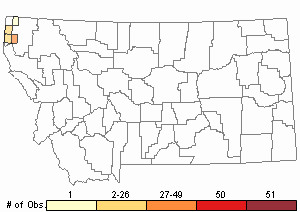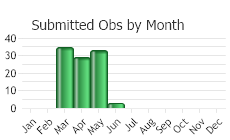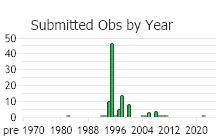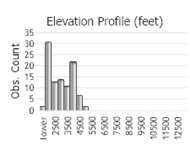View in other NatureServe Network Field Guides
NatureServe
Montana
Utah
Wyoming
Idaho
Wisconsin
British Columbia
South Carolina
Yukon
California
New York
Geyer's Biscuitroot - Lomatium geyeri
State Rank Reason (see State Rank above)
Geyer's biscuitroot occurs in northwest Montana in less than a dozen occurrences, including several large, extensive populations. Encroachment of invasive weeds from nearby infestations into habitat occupied by the species is the primary concern.
General Description
Geyer's Biscuitroot is a glabrous, herbaceous perennial with 1-3 stems that are 15-40 cm tall. These stems arise from a tuberous-thickened taproot that is up to 4 cm in diameter. Leaves are 2-3 times pinnately divided into narrow ultimate segments and are borne on the lower half of the stem or sometimes only at the base. The smallest flower clusters consist of a number of stalked flowers attached at a single point (simple umbels); these clusters are, in turn, stalked and attached at a single point to form compound umbels. The small, leaf-like bracts of the simple umbels are 2-3 mm long. The small white flowers have 5 separate petals attached on top of the ovary. The glabrous fruits are compressed, elliptic in outline, and 7-12 mm long.
Phenology
Flowering end of March-May, fruiting in late May-early June.
Diagnostic Characteristics
Distinguished from glabrous species of Lomatium with thickened taproots in northwestern Montana by a combination of white flowers, fruits 7-12 mm long on 3-5 mm stalks, height mostly less than 30 cm tall, and narrow bracts. The Parsley family contains many species which superficially resemble each other. A technical key must be consulted to distinguish them from each other.
Species Range
Montana Range
Range Descriptions

 Native
Native
Range Comments
Endemic to eastern WA, ID, and Lincoln County (Lesica et al. 2012. Manual of Montana Vascular Plants. BRIT Press. Fort Worth, TX).
Observations in Montana Natural Heritage Program Database
Number of Observations: 102
(Click on the following maps and charts to see full sized version)
Map Help and Descriptions
Relative Density

Recency



 (Observations spanning multiple months or years are excluded from time charts)
(Observations spanning multiple months or years are excluded from time charts)
Habitat
Vernally moist soil in open or partially shaded habitats in the montane zone.
Threats or Limiting Factors
STATE THREAT SCORE REASON
Reported threats to Montana's populations of [common name] are inconclusive; therefore, a NatureServe threat rank could not be assigned (MTNHP Threat Assessment 2021).
References
- Literature Cited AboveLegend:
 View Online Publication
View Online Publication Lesica, P., M.T. Lavin, and P.F. Stickney. 2012. Manual of Montana Vascular Plants. Fort Worth, TX: BRIT Press. viii + 771 p.
Lesica, P., M.T. Lavin, and P.F. Stickney. 2012. Manual of Montana Vascular Plants. Fort Worth, TX: BRIT Press. viii + 771 p.
- Additional ReferencesLegend:
 View Online Publication
View Online Publication
Do you know of a citation we're missing? Lesica, P., M.T. Lavin, and P.F. Stickney. 2022. Manual of Montana Vascular Plants, Second Edition. Fort Worth, TX: BRIT Press. viii + 779 p.
Lesica, P., M.T. Lavin, and P.F. Stickney. 2022. Manual of Montana Vascular Plants, Second Edition. Fort Worth, TX: BRIT Press. viii + 779 p. Mathias, M.E. 1938. A revision of the genus Lomatium. Annals of the Missouri Botanical Gardens 25:225-297.
Mathias, M.E. 1938. A revision of the genus Lomatium. Annals of the Missouri Botanical Gardens 25:225-297. Schlessman, M.A. 1984. Systematics of tuberous LomatiumS (Umbelliferae). Systematic Botany Monographs 4:1-55.
Schlessman, M.A. 1984. Systematics of tuberous LomatiumS (Umbelliferae). Systematic Botany Monographs 4:1-55.
- Web Search Engines for Articles on "Geyer's Biscuitroot"





